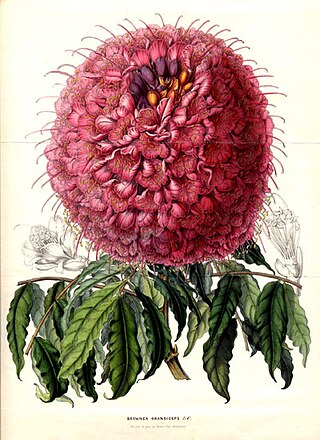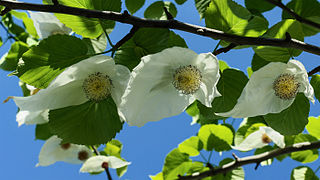
Azadirachta indica, commonly known as neem, margosa, nimtree or Indian lilac, is a tree in the mahogany family Meliaceae. It is one of two species in the genus Azadirachta. It is native to the Indian subcontinent and to parts of Southeast Asia, but is naturalized and grown around the world in tropical and subtropical areas. Its fruits and seeds are the source of neem oil. Nim is a Hindustani noun derived from Sanskrit nimba (निंब).

Yucca brevifolia is a plant species belonging to the genus Yucca. It is tree-like in habit, which is reflected in its common names.

Ficus benjamina, commonly known as weeping fig, benjamin fig or ficus tree, and often sold in stores as just ficus, is a species of flowering plant in the family Moraceae, native to Asia and Australia. It is the official tree of Bangkok. The species is also naturalized in the West Indies and in the states of Florida and Arizona in the United States. It is one of the most common trees in Israeli cities and parks. In its native range, its small fruit are favored by some birds.

Viburnum opulus, the guelder-rose or guelder rose is a species of flowering plant in the family Adoxaceae native to Europe, northern Africa and central Asia.

Cynometra is genus of tropical forest trees with a pantropical distribution.

The subfamily Detarioideae is one of the subdivisions of the plant family Fabaceae (legumes). This subfamily includes many tropical trees, some of which are used for timber or have ecological importance. The subfamily consists of 84 genera, most of which are native to Africa and Asia. Pride of Burma and tamarind are two of the most notable species in Detarioideae. It has the following clade-based definition:
The most inclusive crown clade containing Goniorrhachis marginataTaub. and Aphanocalyx cynometroidesOliv., but not Cercis canadensisL., Duparquetia orchidaceaBaill., or Bobgunnia fistuloides(Harms) J. H. Kirkbr. & Wiersema.

Cynometra cauliflora is a small, cauliflorous tree with a thick, heavily branched stem, and rather small flowers, about 1.2 cm (0.5 in) across, that appear on the stem in clusters. It is known in Indonesian as namu-namu, after the flattened, crescent shaped pods, which look similar to the Indonesian pastry, namu-namu. In the city of Ternate, it is called namo-namo, and ñam-ñam in the Maldives. It is a species of the genus Cynometra, native to Malaysia, and found mainly in northern peninsular Malaysia.
Cynometra vitiensis is a species of plant in the family Fabaceae. It is a tree found only in Fiji.
Cynometra minor is a species of plant in the family Fabaceae. It is a tree found only in Fiji.
Cynometra vestita is a species of plant in the family Fabaceae. It is a tree found only in Fiji, on the islands of Viti Levu and Vanua Levu.
Zenkerella is a genus of plants in the family Fabaceae. It includes six species of evergreen trees native to tropical Africa. One species is native to Nigeria, Cameroon, and Gabon in west-central tropical Africa, where it grows in lowland, riverine, or swamp Guineo-Congolian forest. The other five species grow in Afromontane or coastal Zanzibar–Inhambane forest in Tanzania.

Cardwellia is a monotypic genus in the plant family Proteaceae. The sole described species is Cardwellia sublimis − commonly known as northern silky oak, bull oak or lacewood − which is endemic to the rainforests of northeastern Queensland, Australia.

Gliricidia is a genus of flowering plants in the legume family, Fabaceae and tribe Robinieae. Its native range is Mexico to Peru, but Gliricidia sepium has been widely introduced to other tropical zones.

Cynometra lenticellata is a flowering tropical tree in the family Fabaceae. It is native to tropical semi-deciduous rainforest and gallery forests in northern Queensland, some of the Torres Strait Islands, and New Guinea. Common names include: silk handkerchief tree, cascading bean, and native handkerchief tree.
Cynometra rosea is a species of flowering plants in the family Fabaceae. It is a tree endemic to New Guinea. It belongs to the subfamily Detarioideae.
Michelsonia is a genus of tree in the legume family, Fabaceae, where it is classified in the subfamily Detarioideae. It is a monotypic genus, the only species being Michelsonia microphylla. It is native to the tropical rain forests of the Democratic Republic of the Congo. The wood is used locally for construction work.
The Bugoma Forest is a protected tropical forest that is situated southwest of Hoima and northeast of Kyenjojo towns, and east of Lake Albert, in the Hoima district of western Uganda. It was gazetted in the 1932 and came under the mandate of the National Forestry Authority in 2003. But it was expanded in 1965, 1968 and 1998. Its surface area is given as between 41,144 hectares (411.44 km2) and 65,000 hectares (650 km2).

Davidia involucrata, the dove-tree, handkerchief tree, pocket handkerchief tree, or ghost tree, is a medium-sized deciduous tree in the family Nyssaceae. It is the only living species in the genus Davidia. It was previously included with tupelos in the dogwood family, Cornaceae. Fossil species are known extending into the Upper Cretaceous.
Julbernardia seretii, commonly known as the Congo zebrawood, is a species of legume in the family Fabaceae. It is found in tropical West and Central Africa.

A tree in the family Fabaceae, Cynometra ramiflora is found in mangroves and flooded forests from New Caledonia in the western Pacific west to Queensland in Australia, New Guinea, Island Southeast Asia, and Tropical Asia as far west as India. Its wood is used for construction and fuel, and parts of plant are ascribed medicinal use.











